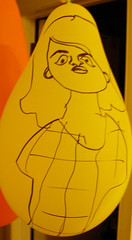This afternoon, Philippa and I rolled down to the Field Museum to take in the Jacqueline Kennedy exhibit. Pippa is an avid student of biographies, and earlier she devoted particular attention to First Ladies. You may remember her Jackie Kennedy balloon at right (included a matching Jack on the reverse of the balloon). When she took out the library books on Jackie Kennedy Onassis, the librarian asked her whether she was going to the exhibit at the Field Museum. We hadn’t been aware that there would be such a thing, so the question became a provocation for this afternoon’s Field trip (so to speak).
We made it to the Field just in time for our 1:30 ticket pick-up (note of advice: Buy tickets in advance online. We coasted past a line that would have lasted a half-hour or so of standing in a winding queue near the chilly vestibule), though the signage for parking at the Field leaves a tremendous amount to be desired. We thus took a scenic tour of the promontory on which the museum, aquarium, and planetarium are situated, only eventually finding our way to the parking garage. Tickets for special exhibits such as this are exorbitant, though if you make it a doubleheader (“Jackie Kennedy and Machu Picchu! Such a deal!”) you save a lot over the cost of separate visits. We didn’t have the time and energy for that, so we contented ourselves with offering our organ donations to get into just the Jackie Kennedy exhibit, then wandering around the rest of the museum as Pippa’s spirit moved her.
The Kennedy exhibit touched me more than I anticipated. I have almost no interest in fashion history, so the array of hats and dresses blurred before my eyes. The letters, films, and memos, however, bespoke a personage of remarkable brilliance of a sort that has to a great extent faded from public awareness, to our impoverishment. Be it granted that the exhibit set out to cast Ms. Kennedy [Onassis] (and Jack) in the best possible light — the discourse of Presidency that the Kennedys enacted diverges sharply from recent presidencies, even though particular policy mistakes may fairly be compared back and forth. The overwhelming impression from the artifacts assembled here pointed toward a literacy and depth I have missed for decades.
In this context, Jacqueline’s cultural alertness, multi-lingual fluency, remarkable taste (not only in clothing, but the arts in general) evoked in me a pang of unexpected nostalgia, but even more profound admiration of this extraordinarily articulate, elegant, accomplished woman.
Her life of privilege certainly made possible opportunities and achievements to which she’d never have access had she been born with similar gifts in rural Appalachia. At the same time, the braying golden asses to whom the Tutor so relentlessly directs our attention represent only one of the fruits of aristocracy; and given the benefits of privilege, Jacqueline Kennedy seems not only not to have wasted them, but rather to have extended herself to make her advantages into benefits for everyone, the true noblesse exemplified by the philanthropists who hang around at GiftHub).
All that being said, boy! there were a lotta dresses. Pippa examined them carefully, read the descriptions (with designer, occasions on which JBK wore the dress, critical analysis of the design), attended to the film clips, soaked up the whole display. When we got home and she told Margaret what we’d seen, she freely supplied details and recounted anecdotes as though she’d been there.
Afterward, we strolled at length through the natural history displays (she gleefully spotted a family of moose, whom she associated with Margaret’s father, and of geese, which she claimed as her own totemic creatures). She surveyed the owls that her great-grandfather loved to etch, and studied the informational panels dedicated to Sue, the Field’s unique Tyrannosaurus Rex, with all the intensity that I used to indulge at the Peabody Museum.
